



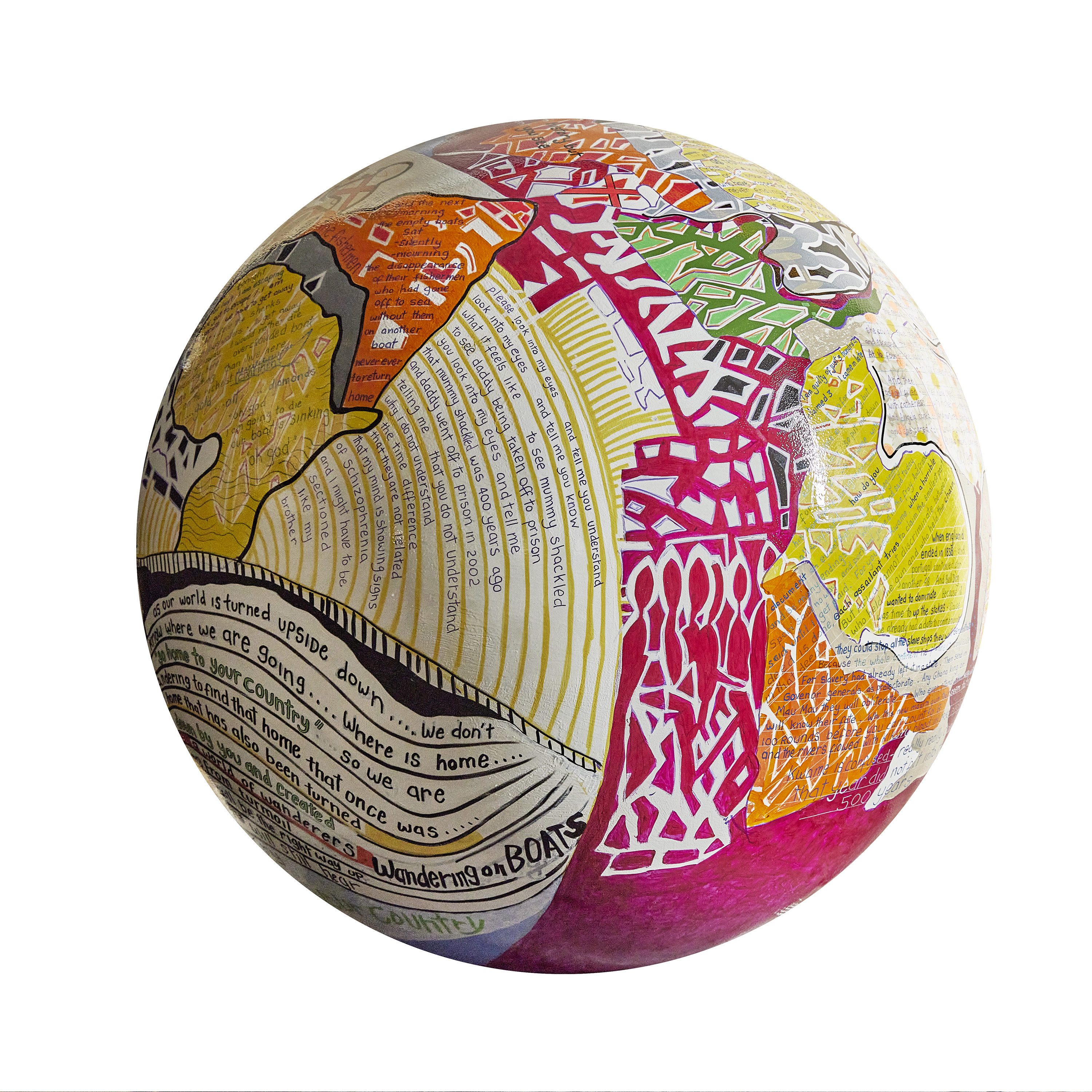
Wanderers Of The EmpireMillions of years ago a comet collided with a land now called Haiti, scattering tons of Iridium that now sells at $6,000 per troy ounce (19/6/22). This now makes the people of the island the poorest rich people on the planet. Five hundred years ago a white bolt s... |
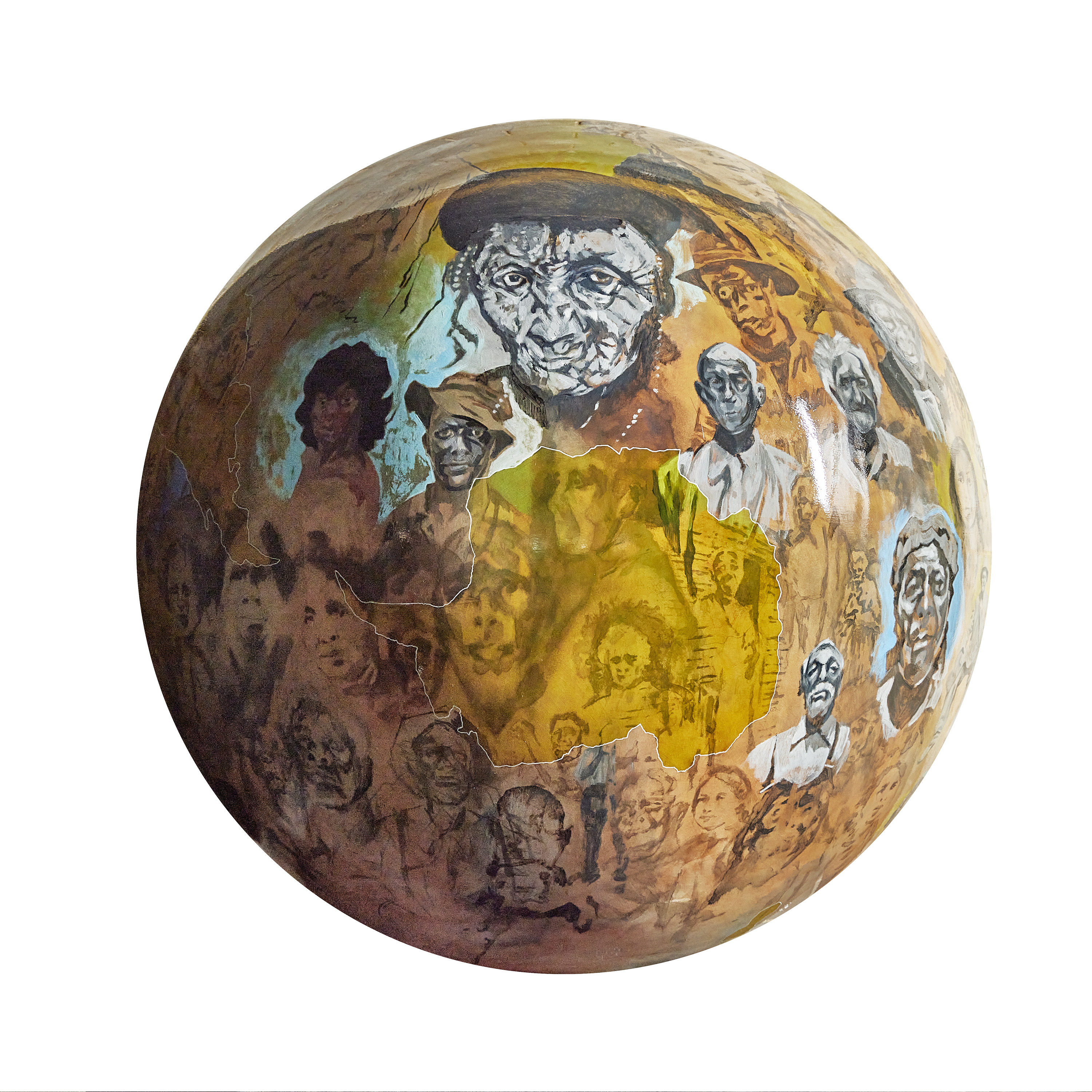
LegacyMany ghosts from the past occupy our public spaces. Their names adorn buildings, streets, sculptures and plaques. These legacies of the Transatlantic Trade in Enslaved Africans haunt our towns and cities, affecting many people who walk past them everyday. Legacy seeks to bring to light the... |

AscensionMy practice has always focused on the positive aspects of Black history. My design focuses on our healing from the past, on unity, and on pride in ourselves and our community. My intention is to convey hope and encourage a sense of self-actualisation, while still honouring our cultural heri... |
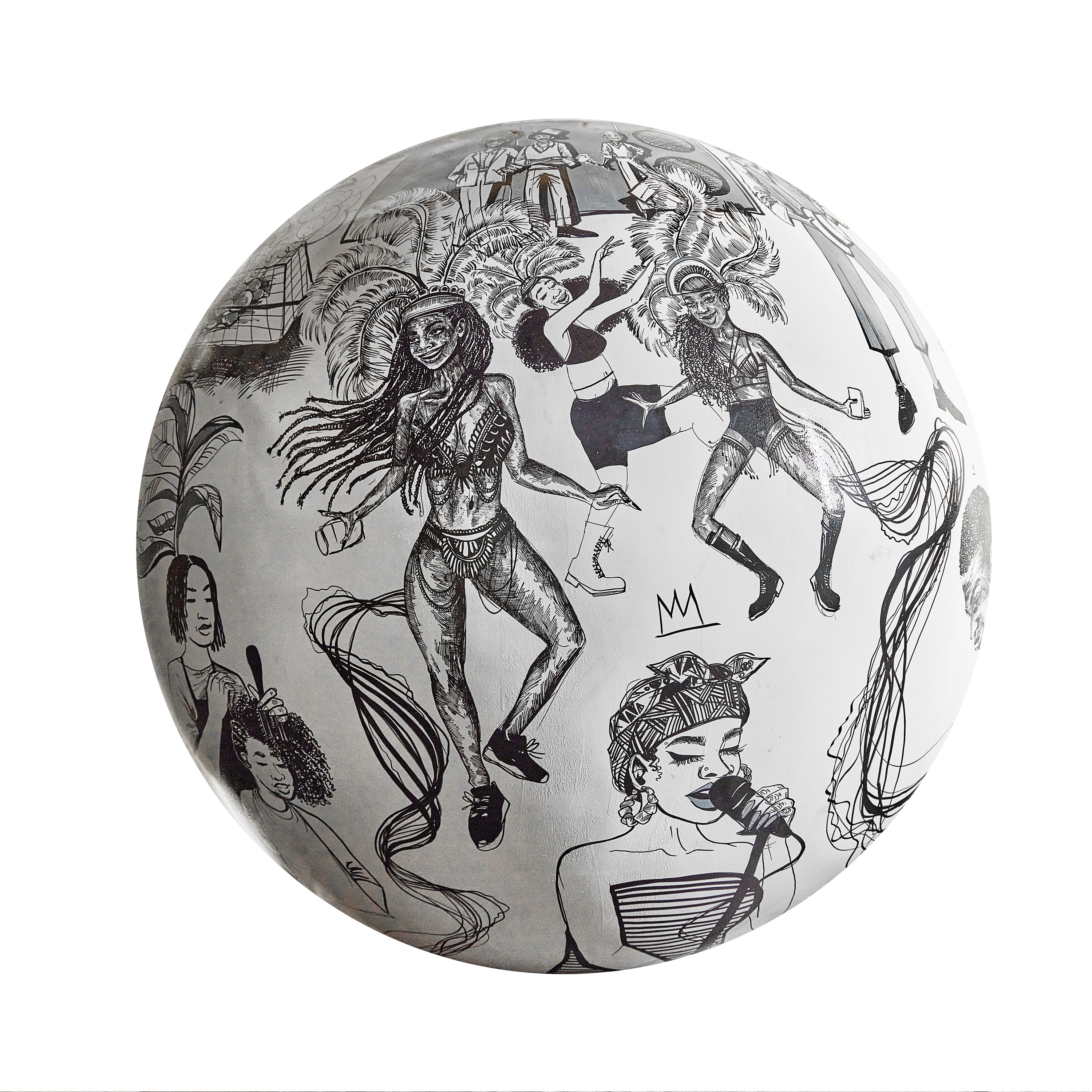
FoundationsMy initial feeling in responding to the theme Expanding Soul, was to create something celebratory, something vibrant and something that embodies soul in its purest forms. I wanted to explore music, community, food, love; elements that are not just connected to, but often rooted in African a... |
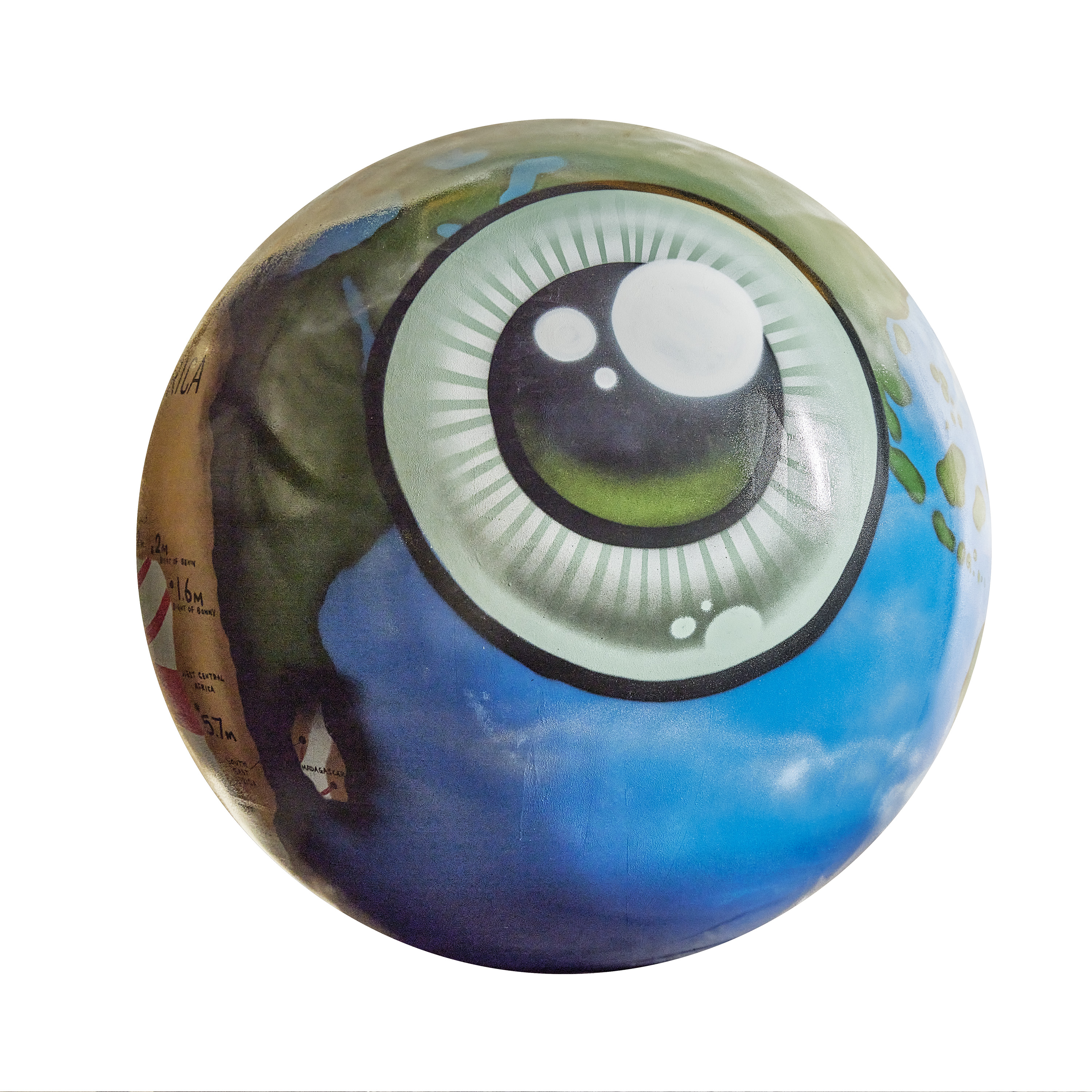
Under The SkinFor this piece, I wanted to show the world in layers, and in doing so show the history of the routes of the Transatlantic Trade in Enslaved Africans, and where our people were taken from and displaced to. I hope we are able to begin to understand the size of this operation and the impact it... |


| Old Market Roundabout |
Bandele's design responds to the theme ‘A Complex Triangle’, which explores the complexity of Britain’s relationship with Africa, the Americas and the Caribbean across generations, and the legacy of the Transatlantic Trade in Enslaved Africans on the UK’s role and reputation in the world.
Millions of years ago a comet collided with a land now called Haiti, scattering tons of Iridium that now sells at $6,000 per troy ounce (19/6/22). This now makes the people of the island the poorest rich people on the planet.
Five hundred years ago a white bolt slammed into the African continent scattering the people in every direction......now on the very day of Abolition 200, in 2006, words of the Ancestors are received through their Messenger, as dyes and paint explode onto cheap calico to open minds and to burn into all the half truth and lies as the words of the Ancestors cause the the white bolt to implode......these are the words of the Ancestors.
With 50 plus years as a self taught professional artist Bandele has been able to make impressive work in quite a few practices in the arts. Notable creative endeavours have been the 21ft batik mural for Bermuda I.U., his first solo show at Trinidad Hilton that bought together the islands top artist and clothing designers. Immigrating to the UK in 1988 he opened his batik painting exhibition at the Commonwealth Institute in London, while that was happening another collection of work was being prepared for a commissioned uk tour for Amnesty International addressing the apartheid situation in South Africa, this exhibition opened at the prestigious Kings College Chapel Cambridge. Over the years he has been involved in numerous creative ventures in Bristol and can boast that he has been involved with every major institution in the city over the years. Presently he is completing a body of over 100 pieces of work including textile, oil paintings, photography, a 10ft mahogany sculpture completed during his lockdown in Trinidad, installations and film for a world tour.
Bandele's design responds to the theme ‘A Complex Triangle’, which explores the complexity of Britain’s relationship with Africa, the Americas and the Caribbean across generations, and the legacy of the Transatlantic Trade in Enslaved Africans on the UK’s role and reputation in the world.
Millions of years ago a comet collided with a land now called Haiti, scattering tons of Iridium that now sells at $6,000 per troy ounce (19/6/22). This now makes the people of the island the poorest rich people on the planet.
Five hundred years ago a white bolt slammed into the African continent scattering the people in every direction......now on the very day of Abolition 200, in 2006, words of the Ancestors are received through their Messenger, as dyes and paint explode onto cheap calico to open minds and to burn into all the half truth and lies as the words of the Ancestors cause the the white bolt to implode......these are the words of the Ancestors.
With 50 plus years as a self taught professional artist Bandele has been able to make impressive work in quite a few practices in the arts. Notable creative endeavours have been the 21ft batik mural for Bermuda I.U., his first solo show at Trinidad Hilton that bought together the islands top artist and clothing designers. Immigrating to the UK in 1988 he opened his batik painting exhibition at the Commonwealth Institute in London, while that was happening another collection of work was being prepared for a commissioned uk tour for Amnesty International addressing the apartheid situation in South Africa, this exhibition opened at the prestigious Kings College Chapel Cambridge. Over the years he has been involved in numerous creative ventures in Bristol and can boast that he has been involved with every major institution in the city over the years. Presently he is completing a body of over 100 pieces of work including textile, oil paintings, photography, a 10ft mahogany sculpture completed during his lockdown in Trinidad, installations and film for a world tour.


| Trinity Community Arts Centre, BS2 0NW |
Adam's design responds to the theme ‘Echoes in the Present’, which focuses on how the Transatlantic Trade in Enslaved Africans and its related history has present day negative consequences: systemic inequalities and injustice; entrenched racism and prejudices; and the generational echoes which have traumatic physical, behavioural, psychological and material impact.
Many ghosts from the past occupy our public spaces. Their names adorn buildings, streets, sculptures and plaques. These legacies of the Transatlantic Trade in Enslaved Africans haunt our towns and cities, affecting many people who walk past them everyday. Legacy seeks to bring to light the forgotten or little known echoes of the past.
Delving into history and archives, this globe seeks to highlight generations who have become lost to time and history. African cultures, indigenous cultures, enslaved people, abolitionists, suffragettes, writers and more who fought for the right to be seen and heard. The Dymaxion Fuller map, invented by Buckminster Fuller, represents a world that has less continent distortion. Other map projections like the Mercator and the Gall–Peters projection creates a distorted view of the world. The distortions on this globe are the people found at the top and bottom of the globe, highlighting how distorted our world can become.
The removal of the north-up /south-down presentation, created by European empires, removes particular narratives that can affect how people view the world through unconscious cultural bias. To improve how we view the world, we must be attentive about how we map reality. We must look with fresh eyes, be cognisant of unconscious bias, and observe our ways of seeing.
Adam Grose specialises in drawing, painting and printmaking. He achieved a BA (Hons) Fine Art in Southampton and qualified to teach in 1997, teaching A Level, OLASS and SEND.
He deepened his practice through studying for an MA in Fine Art Contemporary Practice at Falmouth University, which lead to residencies at the Cyprus College of Art run by Stass Paraskos (2013) and at the Malaca Instituto in Malaga (2014). These opportunities afforded time to research and explore the effect of cultural influences upon a host nation, investigating the dichotomy of a country via the host and the invasive culture, including the influence and ramifications of these forms of colonialism.
Since 2011 Grose has focussed upon the human condition and lost generations, layering to obscure, destroy, hide, cover, manipulate, strip and wash away images and materials, using these forms of making to symbolise the passage of time and the way history affects memory and knowledge in contemporary society. He forms images that appear to be in transition from one state to another, like phantoms or echoes of the past haunting the present.
Adam's design responds to the theme ‘Echoes in the Present’, which focuses on how the Transatlantic Trade in Enslaved Africans and its related history has present day negative consequences: systemic inequalities and injustice; entrenched racism and prejudices; and the generational echoes which have traumatic physical, behavioural, psychological and material impact.
Many ghosts from the past occupy our public spaces. Their names adorn buildings, streets, sculptures and plaques. These legacies of the Transatlantic Trade in Enslaved Africans haunt our towns and cities, affecting many people who walk past them everyday. Legacy seeks to bring to light the forgotten or little known echoes of the past.
Delving into history and archives, this globe seeks to highlight generations who have become lost to time and history. African cultures, indigenous cultures, enslaved people, abolitionists, suffragettes, writers and more who fought for the right to be seen and heard. The Dymaxion Fuller map, invented by Buckminster Fuller, represents a world that has less continent distortion. Other map projections like the Mercator and the Gall–Peters projection creates a distorted view of the world. The distortions on this globe are the people found at the top and bottom of the globe, highlighting how distorted our world can become.
The removal of the north-up /south-down presentation, created by European empires, removes particular narratives that can affect how people view the world through unconscious cultural bias. To improve how we view the world, we must be attentive about how we map reality. We must look with fresh eyes, be cognisant of unconscious bias, and observe our ways of seeing.
Adam Grose specialises in drawing, painting and printmaking. He achieved a BA (Hons) Fine Art in Southampton and qualified to teach in 1997, teaching A Level, OLASS and SEND.
He deepened his practice through studying for an MA in Fine Art Contemporary Practice at Falmouth University, which lead to residencies at the Cyprus College of Art run by Stass Paraskos (2013) and at the Malaca Instituto in Malaga (2014). These opportunities afforded time to research and explore the effect of cultural influences upon a host nation, investigating the dichotomy of a country via the host and the invasive culture, including the influence and ramifications of these forms of colonialism.
Since 2011 Grose has focussed upon the human condition and lost generations, layering to obscure, destroy, hide, cover, manipulate, strip and wash away images and materials, using these forms of making to symbolise the passage of time and the way history affects memory and knowledge in contemporary society. He forms images that appear to be in transition from one state to another, like phantoms or echoes of the past haunting the present.


| St Paul's Learning Centre, BS2 8XJ |
The work of making racial justice a reality must be rooted in community – in our individual and collective experiences, hopes and contributions. Michele’s design was created in response to dialogue and workshops with local communities.
My practice has always focused on the positive aspects of Black history. My design focuses on our healing from the past, on unity, and on pride in ourselves and our community. My intention is to convey hope and encourage a sense of self-actualisation, while still honouring our cultural heritage and history.
The work of making racial justice a reality must be rooted in community – in our individual and collective experiences, hopes and contributions. Michele’s design was created in response to dialogue and workshops with local communities.
My practice has always focused on the positive aspects of Black history. My design focuses on our healing from the past, on unity, and on pride in ourselves and our community. My intention is to convey hope and encourage a sense of self-actualisation, while still honouring our cultural heritage and history.


| Grosvenor Road Triangle |
Jasmine's design responds to the theme ‘Expanding Soul’, which celebrates the spirit and culture of the African diaspora that, even in the face of incredible suffering, has endured and found vibrant expression across the world in music, art, food and so much more.
My initial feeling in responding to the theme Expanding Soul, was to create something celebratory, something vibrant and something that embodies soul in its purest forms. I wanted to explore music, community, food, love; elements that are not just connected to, but often rooted in African and Caribbean culture.
There is so much beauty to celebrate, so choosing a small selection of images to represent the joy and beauty of it was incredibly challenging, and there is so much more that could have been included. I wanted people to see images that resonate with them; whether it's the young girl sat between the knees or her auntie getting her hair braided, the women laughing and dancing, or the guys in the studio making music.
For me it was important to include one anecdote that connects me to this work too, hence drawing in an old photo of my grandfather and cousin that's particularly close to my heart. I was inspired from the moment my pen touched the globe, and thoroughly enjoyed the creative process of making this work. I just hope this piece – as the theme suggests – opens and soothes the souls of those who see it.
Jasmine is a Bristol based illustrator, mural artist, and designer. Her practise embodies using traditional art methods (illustration) that tells stories of people and places. Amongst her recent work are murals for Royal Shakespeare Company and Pervasive Media Studio. She works regularly as a live sketch artist and visual journalist, and represents corporate organisations live sketching conferences, and designing Infographics for reports and books. She is an experienced political cartoonist for magazines, conveying a political, cultural or social stance in a way that is smart, sensitive and engaging. She is also a regular workshop facilitator and works with both children and adults, and is currently a board member for creative enterprise Rising Arts Agency.
Jasmine's design responds to the theme ‘Expanding Soul’, which celebrates the spirit and culture of the African diaspora that, even in the face of incredible suffering, has endured and found vibrant expression across the world in music, art, food and so much more.
My initial feeling in responding to the theme Expanding Soul, was to create something celebratory, something vibrant and something that embodies soul in its purest forms. I wanted to explore music, community, food, love; elements that are not just connected to, but often rooted in African and Caribbean culture.
There is so much beauty to celebrate, so choosing a small selection of images to represent the joy and beauty of it was incredibly challenging, and there is so much more that could have been included. I wanted people to see images that resonate with them; whether it's the young girl sat between the knees or her auntie getting her hair braided, the women laughing and dancing, or the guys in the studio making music.
For me it was important to include one anecdote that connects me to this work too, hence drawing in an old photo of my grandfather and cousin that's particularly close to my heart. I was inspired from the moment my pen touched the globe, and thoroughly enjoyed the creative process of making this work. I just hope this piece – as the theme suggests – opens and soothes the souls of those who see it.
Jasmine is a Bristol based illustrator, mural artist, and designer. Her practise embodies using traditional art methods (illustration) that tells stories of people and places. Amongst her recent work are murals for Royal Shakespeare Company and Pervasive Media Studio. She works regularly as a live sketch artist and visual journalist, and represents corporate organisations live sketching conferences, and designing Infographics for reports and books. She is an experienced political cartoonist for magazines, conveying a political, cultural or social stance in a way that is smart, sensitive and engaging. She is also a regular workshop facilitator and works with both children and adults, and is currently a board member for creative enterprise Rising Arts Agency.


| Broadmead |
3dom's design responds to the theme ‘Reimagine the Future’, which gives us free rein to imagine the society we can create when we have a full understanding of our shared history; the place the UK can hold in the world when it acknowledges its past; and who we can be as people and a country when we give full dignity to all.
For this piece, I wanted to show the world in layers, and in doing so show the history of the routes of the Transatlantic Trade in Enslaved Africans, and where our people were taken from and displaced to. I hope we are able to begin to understand the size of this operation and the impact it had and still has on the history of our earth.
3Dom is one of Bristol’s new generation of street artists, who regularly paints amazing pieces in a liberal city that has a history of supporting artists. 3Dom is an appropriate name – He regularly combines disparate images in the same characters, ranging from lemons to weight’s bars, treehouses and cages. 3Dom’s vivid imagination, combined with his sense of humour, makes each one of his characters original, unmistakable and a pleasure to find on the street.
3dom's design responds to the theme ‘Reimagine the Future’, which gives us free rein to imagine the society we can create when we have a full understanding of our shared history; the place the UK can hold in the world when it acknowledges its past; and who we can be as people and a country when we give full dignity to all.
For this piece, I wanted to show the world in layers, and in doing so show the history of the routes of the Transatlantic Trade in Enslaved Africans, and where our people were taken from and displaced to. I hope we are able to begin to understand the size of this operation and the impact it had and still has on the history of our earth.
3Dom is one of Bristol’s new generation of street artists, who regularly paints amazing pieces in a liberal city that has a history of supporting artists. 3Dom is an appropriate name – He regularly combines disparate images in the same characters, ranging from lemons to weight’s bars, treehouses and cages. 3Dom’s vivid imagination, combined with his sense of humour, makes each one of his characters original, unmistakable and a pleasure to find on the street.

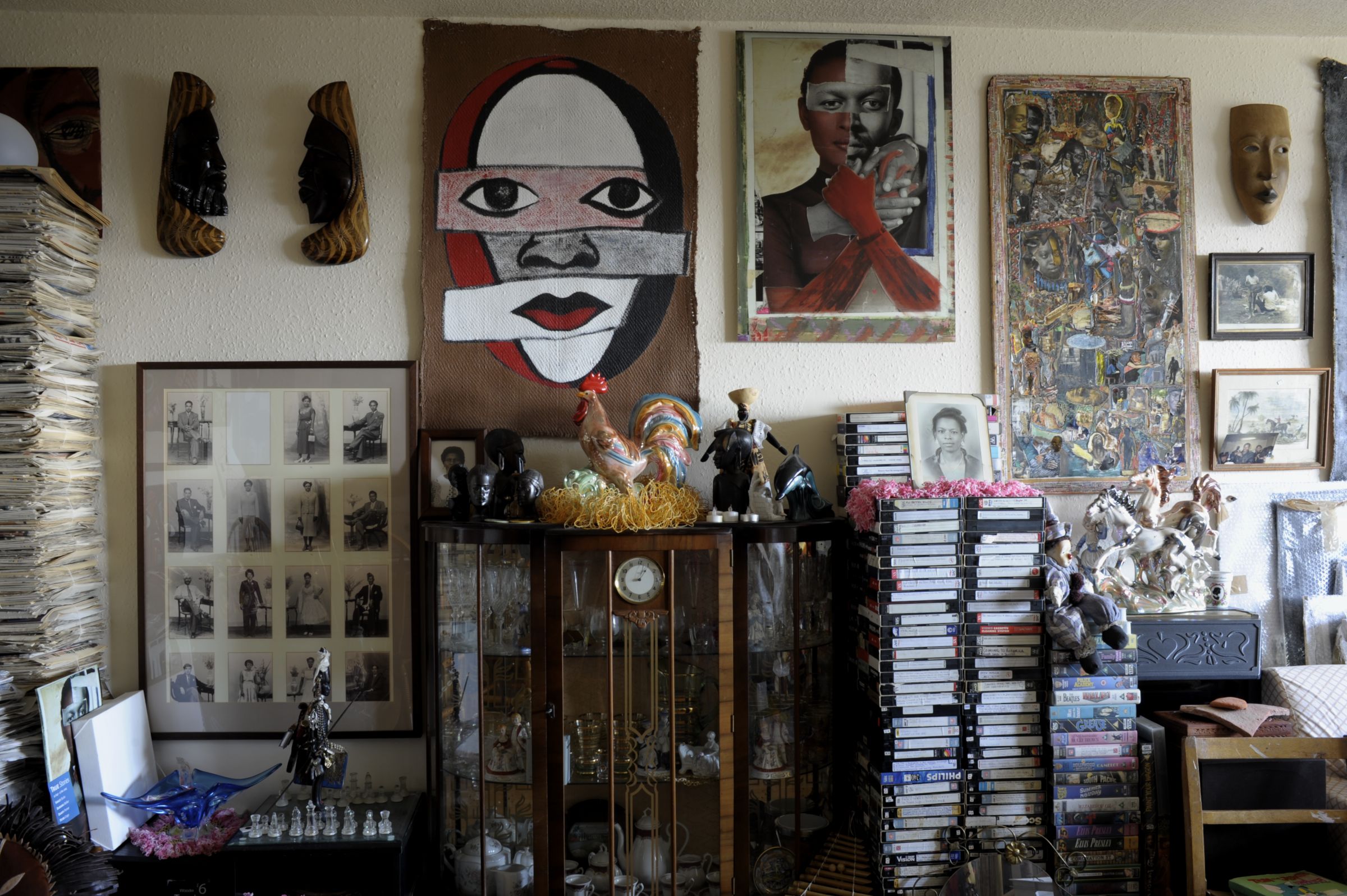
| Ikon Gallery |
Vanley Burke, also known as the godfather of Black British photography, is a Birmingham based photographer and archivist. Born in Jamaica in 1951, he moved to Birmingham in 1965. Since then he has been responsible for documenting the lives and experiences of Caribbean diaspora communities in the UK, capturing images of everyday life and significant events such as the 1985 Handsworth uprisings for more than half a century.
In 2015, he had an exhibition at Ikon Gallery: At Home With Vanley Burke, which had on display items from his personal collection usually found in his flat in Nechells, near Birmingham’s city centre. The collection was described as “a cabinet of wonderful curiosities… An archive with artworks and souvenirs, as well as decor and furniture, wardrobe, kitchenware etcetera – so that the artist is revealed as a subject of his own enquiry. Vanley Burke’s personal story, involving such a vital archival impulse, is integral to the bigger picture he is making for us, on this occasion with the help of many others.” (Ikon Gallery)
Image Courtesy of Ikon Gallery
Vanley Burke, also known as the godfather of Black British photography, is a Birmingham based photographer and archivist. Born in Jamaica in 1951, he moved to Birmingham in 1965. Since then he has been responsible for documenting the lives and experiences of Caribbean diaspora communities in the UK, capturing images of everyday life and significant events such as the 1985 Handsworth uprisings for more than half a century.
In 2015, he had an exhibition at Ikon Gallery: At Home With Vanley Burke, which had on display items from his personal collection usually found in his flat in Nechells, near Birmingham’s city centre. The collection was described as “a cabinet of wonderful curiosities… An archive with artworks and souvenirs, as well as decor and furniture, wardrobe, kitchenware etcetera – so that the artist is revealed as a subject of his own enquiry. Vanley Burke’s personal story, involving such a vital archival impulse, is integral to the bigger picture he is making for us, on this occasion with the help of many others.” (Ikon Gallery)
Image Courtesy of Ikon Gallery

Login or Register to track the Globes you visit for chance to win a FREE copy of The World Reimagined book!
Find Out More


Artist Globe |
Learning Globe |
Points of Interest |